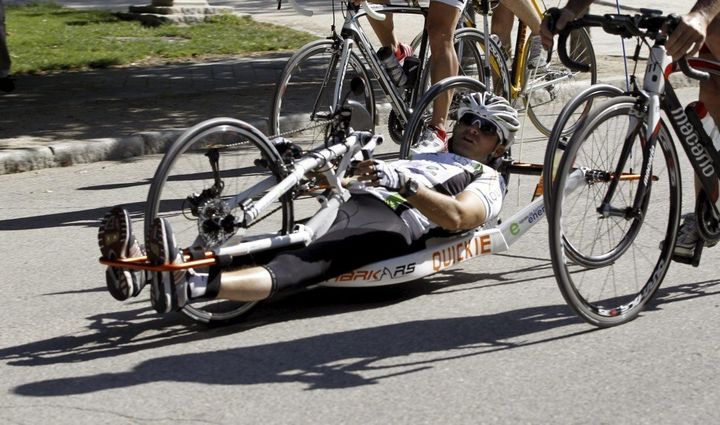
Almost half of disabled cyclists are afraid of being seen cycling, in case being “too active” costs them their benefits, according to campaigners, while some are so afraid they cut down or give up cycling altogether.
A survey of 202 cyclists by disabled cycling charity, Wheels for Wellbeing, found while most disabled cyclists (72%) use their cycles as mobility aids, and three quarters find cycling easier than walking. While 17% of those who fear of being seen as too active ride less as a result, 6% of disabled cyclists actually had their benefits reduced or withdrawn because they cycle.
Of around 11.5 million disabled people in England, nearly half (42%) are inactive each week, according to Public Health England, and disabled people are twice as likely to be inactive as those without disabilities.
Isabelle Clement, director of Wheels for Wellbeing, said: “If it’s stopping people cycling it is also probably stopping them trying to do any physical activity, because people are so concerned about the hostile environment out there.
“It condemns them to worse health, shorter lives and social isolation, which can lead to depression. I am sure this isn’t the policy intention but it is a result of the current environment.
“I think the government needs to really tackle that through statements, through clarifications; really get the message out once it’s aware of it, which by now it must be.
“Otherwise, even with the best and most inclusive cycling infrastructure, those who could benefit most won’t be able to access it”.
The survey results mirror findings from the Activity Alliance, released last month, which found 47% of disabled people fear benefits loss if they are seen as too active.
John, who is in his late 50s, was born with cerebral palsy, and struggles to walk. He has cycled since the age of six, but he stopped four years ago when a neighbour started photographing him on his bike. He feared he would be reported and his benefits taken away.
He said: “I can’t walk properly, walking is dangerous for me, because I have falls, but if I get on a bike or get in a swimming pool then you can’t tell I have got cerebral palsy.
“I used to cycle to work every day. I haven’t cycled for four years, and it has ruined my life; it’s awful.
“Cycling to me is just as important as the day I fell in love.
“I thought I would be cycling until I was 90. I was going to put a badge on the bike saying ‘I’m a disabled cyclist, if you knock me over and kill me don’t blame yourself, this is the way I would have wanted to go, out on my bike’.”
The survey found while some disabled cyclists own non-standard cycles, like recumbent tricycles, or bikes with electrical assist, 43% own a standard two-wheeled cycle, making it hard for others to tell they are disabled. Almost half (45%) of respondents were asked to dismount their cycle, which can be hard for someone who struggles to walk and 37% of disabled cyclists had encountered abuse or disability hate crime while cycling.
Wolf Simpson, who lives in Colchester, works in Boots four days per week, but he suffers from a medical condition causing pain in his legs. Cycling was part of the physiotherapy that helped him walk, and work again.
“I spent a good 20 or so years permanently on a stick and now I cycle to help me stay off them,” he said.
“If I haven’t cycled for a couple of weeks my legs hurt me.
“I’m limited on the hours I do because of my disability, so my finances are very strained.”
Wolf needs a ‘cruiser-style’ electric bike, which reduces pressure on his knees, and which he can sit on to ‘walk’ through a pedestrianised high street where cycling is banned. He is converting a standard bike himself to save money, and hopes to commute to work on it. Wheels for Wellbeing’s survey found 36% of disabled cyclists couldn’t afford a non-standard cycle, and the charity wants the government to help improve access to such bikes.
Natalie Wilson has Ehlers-Danlos syndrome (EDS), affecting her connective tissues. Five years ago she couldn’t walk to the shops, and she began cycling to strengthen her muscles – after which her personal independence payments (PIP) of £900 a month were stopped.
“The minute the assessor knew I cycled, you could see she had decided I wasn’t going to get any more and at the time I don’t think that was justified; having said that two years later I don’t believe I should get anything now.”
Cycling has helped Natalie to work full time, and this year she cycled the entire coast of the UK on a recumbent tricycle.
Natalie now works for the EDS charity, helping others with her condition become more active, and access the help they need.
“I talk to people every day about PIP for the charity and it is completely down to your assessor, how they read you that day, and how they want to interpret that.”
She cycles to keep fit, and fears a loss of mobility if she stops or reduces her cycling. “I still take 20 tablets a day, but because my muscles are so strong I’m not having so many underlying issues,” she said.
The Department for Work and Pensions has been approached for comment.